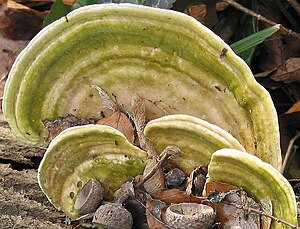Humpback Tramete
| Humpback Tramete | ||||||||||||
|---|---|---|---|---|---|---|---|---|---|---|---|---|

The fruiting bodies of the humpback tramete are often overgrown with green algae. |
||||||||||||
| Systematics | ||||||||||||
|
||||||||||||
| Scientific name | ||||||||||||
| Trametes gibbosa | ||||||||||||
| ( Pers. ) Fr. |
The humpback tramete ( Trametes gibbosa ) is a species of fungus from the family of stem porlings .
features
Macroscopic features
The humpback ramete forms 5–15 cm, in some cases also up to 20 cm wide, creamy to greyish-white fruiting bodies, which are fan-shaped or console-shaped on the substrate and are often thickened like a hump at the point of attachment. The surface is velvety and zoned, often it is colored green by algae growth. The tube layer that can not be detached from the trama is whitish, the pores are elongated and 0.5–1.0 mm wide. The humpback ramete can appear in many forms, especially the eponymous thickening at the attachment point does not always have to be clearly pronounced. The elongated pores distinguish the species well from similar mushrooms. The meat is tough and compact and becomes rock-hard when dried. The color of the spore powder is creamy white.
Microscopic features
The spores are narrow, 1.5–5 µm in size, ellipsoidal to cylindrical in shape, without germ pore and inamyloid . The trama consists of trimitic hyphae , i.e. H. there are generative hyphae, connective hyphae and skeletal hyphae. Buckle formation occurs, there are spindle-shaped, thin-walled cystids 15–20 µm in length.
Ecology and phenology
The humpback tramete occurs mainly in beech forests, also in oak and hardwood forests, as well as in wet floodplain areas. It is less common outside of closed forests. The humpback tramete is a saprobiontic wood dweller that occurs on stumps and lying, thicker hardwood trunks and produces a white rot there, and standing trunks are more rarely colonized. It likes to grow on beech, but is also not uncommon on other hardwoods, the infestation of coniferous wood is very rare. Overall, a broad spectrum of hardwoods is colonized in the south of the European distribution area, while the common beech is increasingly preferred to the north until it becomes the only substrate.
The fruiting bodies can be found all year round.
distribution
The humpback tramete is widespread in Europe and Asia (as far as China, Korea, Japan, south to India), in Europe its distribution area in the south, north and west coincides with that of the common beech, only in Eastern Europe does it go well beyond this. In the north of the Hebrides, beech populations are still being planted. In Germany, the species is widespread and only rarely found in dry and pure coniferous forest areas.
meaning
The humpback tramete is not an edible mushroom, it hardly appears as a wood pest.
literature
- German Josef Krieglsteiner (Ed.): The large mushrooms of Baden-Württemberg . Volume 1: General Part. Stand mushrooms: jelly, bark, prick and pore mushrooms. Ulmer, Stuttgart 2000, ISBN 3-8001-3528-0 .
- Ewald Gerhardt: The great BLV mushroom guide for on the go . 2nd revised edition. BLV, Munich et al. 2001, ISBN 3-405-15147-3 .

